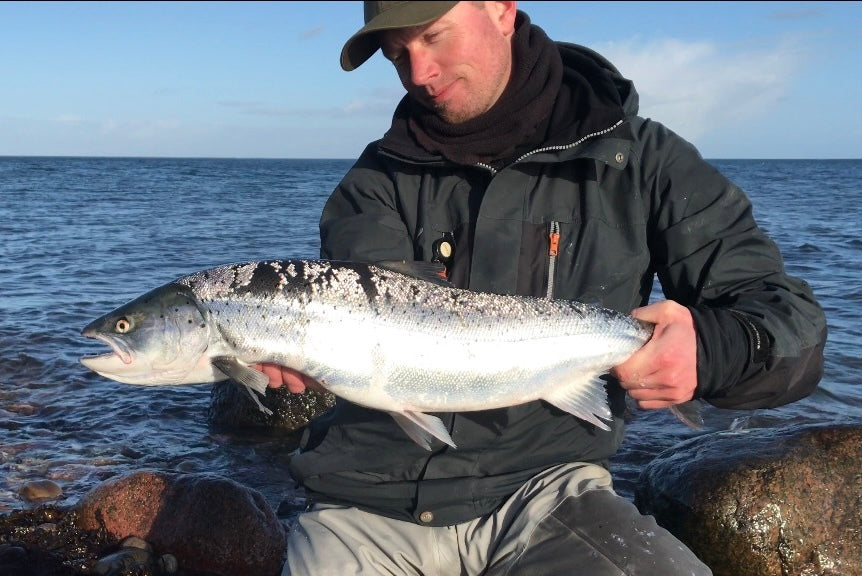(Written by Torben Smedegaard)
For me, the big chromer on the open coast, remains one of the biggest challenges that the modern sportsfisherman can face in Denmark during the winter time.
When the cold kicks ind, there will be a lot fewer seatrout on the coast, since many of them will be in the rivers to spawn. We will still face immature fish who can’t yet spawn. These will often be between 30-50cm and roam around in bigger groups. But if we are lucky, we will be able to face one of the big chromers, which won’t go spawning this season to secure that the genetic pool of the trout won’t be lost, if there should be a population wipe in the trout´s spawning river.
These big chromers are fat, strong and pure silver. They will periodically roam close to the shorelines to find warmer waters, when the wind is blowing cold water away from shore, which makes warm water able to come close to the coast. It can also be the search of food, since the supply is way more scarce during this time of year. Every single one of us who has tried to hunt one of these chromers will know that it requires iron will, luck, skill and patience.
It’s mainly about being in the right place at the right time. When this finally happens, the feeling of success is truly overwhelming, since it is such a hard hunt!
The big chrome on the coast is an equally big achievement as the hunter who finally gets his big stag in the woods.

Spin or fly?
For many people this question will be all about what they like to fish with. Personally, I love both forms of fishing. The spinning rod, which always is my Zpey Zpin 9,5’ & 5-19g with a Shimano Vanquish reel, is a nice and very light setup. This makes me capable of fishing for days and days without tiring out. It also makes smaller fish between 30-50cm very fun to catch, which is important, since those are the ones you are mainly going to find on your hunt.
The spinning rod is a very effective tool if you are searching for fish, if the wind is howling or if it is just hard do casts with the flyrod. The flyrod is furthermore very effective if you know where the fish are or if you just in general know your fishing spot very well, and know where the fish will hang out. The setup I use here is a #7 Zpey Zalt with the Zpey Zalt Minitip.
The #7 rod is perfect, since it can handle quite a bit of wind and still won’t be too clumsy for days with no wind, where it can still present even the smallest fly in a smooth way, that won’t spook the seatrout. If you find yourself upon the coast on a day with no or minimal wind, this fact will make a world of a difference and be the key that leads you to success with these elusive trout.
Which bait should I use?
If you ask 10 different fishermen, you will most likely get 10 different answers.
For me it is all about having as few baits as possible to choose from, but all have to be someone you are very confident about.
This is what I use:
Spinning rod
Here I use “Sillingen” and “Bornholmerpilen” in 17 or 20gram. The colors for these baits is White-Pink, Red-Black or Green-Silver. I also use a fly while fishing like this. This fly is tied on the main line 50-70cm above my main lure. This fly is always a “Flammen” or a “Polar Magnus”.
Often, I’ll fish with a bombarda float of the brand “Milo” in 15gram. When fishing like this the flies will be “Flammen”, “Polar Magnus”, “Pattegris” or “Glimmereje”. All of these flies can be fished very fast and will float steadily in the water if you stop your retrieve to lure the trout to take.

I always use small size 12-14 treble hooks on a release tackle or L-rig when fishing with spin.
The hookup is way better and I’ve landed way more of the seatrout above 3kg that I’ve hooked, by using this method. I always use small size 12-14 treble hooks on a release tackle or L-rig when fishing with spin.
The hookup is way better and I’ve landed way more of the seatrout above 3kg that I’ve hooked, by using this method.

Flyrod
When fishing with the flyrod, my favorite flies is “Pattegris” in the colors pink or white, “Regnbuesvinget”, “Polarmagrnus” or a “Glimmerreje” in pink. Sometimes I use a small size 12-14 secondary fly on my leader. This is always a small “kobberbasse” or a small pink fly. Be careful when using a secondary fly like this, since it could get a problem when bigger fish is going into the weeds, and snagging the other fly on your leader into the weeds.
I use normal hooks from Ahrex, since the advantages that you get from small treble hooks, do not apply in the same way when fly fishing.
Always tie your fly up in a loop, so it can work more naturally in the water and look super tasty for the seatrout and lure them in.

Fishing technique
I always go to the open coastlines to hunt big silver. Usually on Djursland, Fyn or Langeland. I do this because the open coast is the place for adventure and the endless grind for the biggest and baddest trout that you will be able to hunt.
If the fishing has been bad for me over several trips, I sometimes take a small trip to the fjord to catch a few smaller fish. This is important for the self-esteem that you need whilst grinding for your trophy trout. The fjords that I visit is mainly Limfjorden, Horsens Fjord, Kolding Fjord or Gamborg Fjord. Here you can also hit a big chromer, especially if the water temperatures go way down to 0-2 degrees.
This is mostly late in the winter, as the deeper waters on the open coast will be holding higher temperatures in general in the early winter.
Wind and weather is always an important factor! Smaller waves, current and a little sediment in the water is the key combination to big trout. Deep water with lots of current, that goes by close to the shoreline is what you want. This makes bigger trout travel very close to land, in the pursuit of baitfish.
If the wind is blowing directly away from the coast, you could end up getting the cold surface water blown out into the ocean, which makes it possible for warm water to get close to the coast from deep depths. This can often lead to success as well.
When going for these fish, I will always try to cover a lot of water – as much as possible! I’m out there to find the fish, and not the other way around. I move very fast along the coast and always as close to the coast as possible, not wading that deep. If I can fish from land, this is what I’ll do. This way I won’t spook any fish and I will present my bait in even more water, where a giant could lurk. Even very big fish can hide in very shallow water. If there’s no fish on my chosen spot, I will quickly drive to the next spot and search for fish here. It needs to be a perfect stone reef or holding spot for trout, before I spend more than 10 minutes in the same spot. You need to move quickly and cover a lot of water. This way makes it possible to fish 3-5 spots in a single day of fishing and that’s how you achieve almost no trips, where you don’t catch any trout at all.

My perfect day on the coast
Last winter in the end of February, I had one of those dream tours that all of us are dreaming of every time we fish the open coast. At this point I had spent 10-12 whole days on the coast, which led to many smaller fish, and a few 50-55cm trout but no real chrome yet.
The first spot I fished that morning had a great current flowing from right to left. This made the water a bit murky, but it was clearing up. First cast I had a nice 55cm fish hit my lure. In the next few casts, I had several fish following my lure. Picky fish - which meant it was time for the flyrod.
Now that I’ve found the fish, the flyrod was perfect to lure them all the way. A few casts later a nice 53cm trout inhaled my “pink glimmerreje”. I took this fish for my family, which enjoyed it grilled with lemon, herbs and fresh homemade hollandaise sauce.
After a few hours, the current died and the fishing slowed down. I’ve had eight fish in the net at this point. The wind had gone in a different direction, which meant that a spot that I knew would have perfect conditions.
I drove 10 km to the next spot, where the wind was pretty rough. The conditions were excellent though, and a few big boulders 60-70 cm out would most likely be holding a few trout.
I chose a spinning rod to be able to reach these rocks and equipped a “Bornholmerpil” with a “Flammen” fished above it. I fished the stony reef with this setup, but with very little luck. I quickly decided that the pocket 100 m down the coast could hold warmer water and good amounts of fish.
Jackpot! Within very little time I had landed four nice trout, with the biggest one above 50 cm. All the fish were released, since I had food for the family already. On my way back to the car, I always fish the stones that are 60-70 m out, once more. The first cast that I took to the one boulder quickly got hammered by something heavy. I knew that this was the fish that I was looking for. A few second after my lure got hammered, the fish took a 50 m run and several jumps into the air. Big heavy splashes! I fought this fish very hard, to get it in as quickly as possible. Five minutes later I had a dreamy fish in my net.
A gorgeous fish of 4,4kg and 73cm! Absolutely a dreamy fish.
The fish took the little fly and not my lure, which is why the secondary bait that you use can often make a huge difference.
For the next 30 minutes I just sat there with my fish and enjoyed the moment, took pictures and send the pictures to my dearest fishing friends. I drove home and stopped by Andreas Lyngø to show him the fish, which he was pretty stoked about. When I got home, I celebrated with a nice bottle of wine. What a day!
The rest of the winter was without any more chromers for my part. But I had a fish of the same size inhaling my bombarda float right in front of me, witch broke my bombarda totally.
This tells you what kind of fishing this is. It requires a lot of luck and stamina. And even if you have the luck, you only get very very few chances with these kind of fish.
Whilst you are grinding for that flawless fish, you are surrounded by stunning nature and the dream of that epic silver in your net. I simply cannot wait for the winter to kick in once again, so I can go chasing silver once more.
Tight lines!

